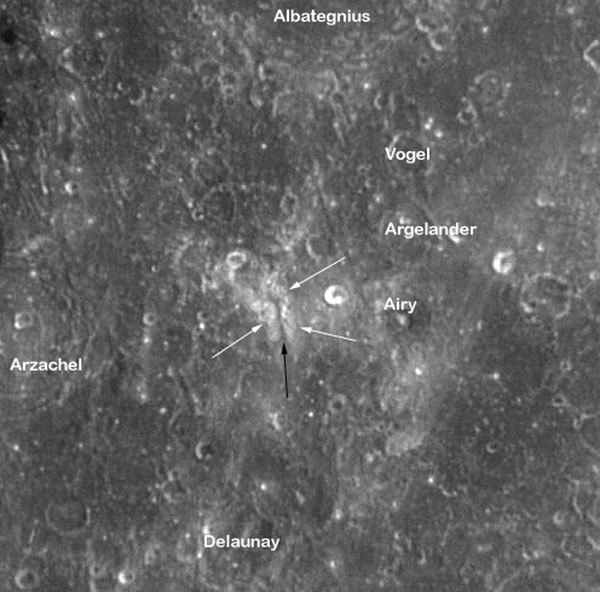Difference between revisions of "LPOD Feb 10, 2008"
(Created page with "<div id="content_view" class="wiki" style="display: block"> =AIRY SWIRL= <br /> LPOD-Feb10-08.jpg<br /> ''image by [mailto:HowardEskildsen@msn.co...") |
|||
| (2 intermediate revisions by the same user not shown) | |||
| Line 1: | Line 1: | ||
<div id="content_view" class="wiki" style="display: block"> | <div id="content_view" class="wiki" style="display: block"> | ||
=AIRY SWIRL= | =AIRY SWIRL= | ||
| − | <br /> [[Image:LPOD-Feb10-08.jpg|LPOD-Feb10-08.jpg]]<br /> ''image by [mailto:HowardEskildsen@msn.com Howard Eskildsen]''<br /> <br /> As soon as I started seriously observing the full moon, I noticed this strange, bright-albedo feature east of Arzachel and wondered what possibly could have caused it. It is stands out at high sun angles, even at low power views of the full moon, and I was surprised that I had never seen it mentioned before. Later, I ran across a couple of references that suggest that it is a lunar swirl associated with a magnetic anomaly. It appears to have been first described as the "Airy Swirl" in a short 2006 [http://www.lpi.usra.edu/meetings/lpsc2006/pdf/1230.pdf paper] by Hughes, Blewett, Hawke, and Richmond. White arrows on the labeled photo point to the bright margins of the swirl and the dark arrow points to the dark lane between the bright features. This area is truly intriguing and deserves further study. <br /> <br /> ''Howard Eskildsen''<br /> <br /> '''Technical Details'''<br /> Dec 21, 2007, 23:49 UDT, Meade 6" f/8 refractor, 2X Barlow, Orion StarShoot II, Seeing 5/10, Clarity 4/6<br /> Argelander D is the small bright crater near the center of the image.<br /> <br /> '''Related Links'''<br /> Rükl plates 55 & 56<br /> <br /> '''[ | + | <br /> [[Image:LPOD-Feb10-08.jpg|LPOD-Feb10-08.jpg]]<br /> ''image by [mailto:HowardEskildsen@msn.com Howard Eskildsen]''<br /> <br /> As soon as I started seriously observing the full moon, I noticed this strange, bright-albedo feature east of Arzachel and wondered what possibly could have caused it. It is stands out at high sun angles, even at low power views of the full moon, and I was surprised that I had never seen it mentioned before. Later, I ran across a couple of references that suggest that it is a lunar swirl associated with a magnetic anomaly. It appears to have been first described as the "Airy Swirl" in a short 2006 [http://www.lpi.usra.edu/meetings/lpsc2006/pdf/1230.pdf paper] by Hughes, Blewett, Hawke, and Richmond. White arrows on the labeled photo point to the bright margins of the swirl and the dark arrow points to the dark lane between the bright features. This area is truly intriguing and deserves further study. <br /> <br /> ''Howard Eskildsen''<br /> <br /> '''Technical Details'''<br /> Dec 21, 2007, 23:49 UDT, Meade 6" f/8 refractor, 2X Barlow, Orion StarShoot II, Seeing 5/10, Clarity 4/6<br /> Argelander D is the small bright crater near the center of the image.<br /> <br /> '''Related Links'''<br /> Rükl plates 55 & 56<br /> <br /> '''[[LPOD%20Index|Index]] of past LPOD's'''<br /> <br /> <br /> <br /> </div> |
Latest revision as of 13:38, 15 April 2018
AIRY SWIRL

image by Howard Eskildsen
As soon as I started seriously observing the full moon, I noticed this strange, bright-albedo feature east of Arzachel and wondered what possibly could have caused it. It is stands out at high sun angles, even at low power views of the full moon, and I was surprised that I had never seen it mentioned before. Later, I ran across a couple of references that suggest that it is a lunar swirl associated with a magnetic anomaly. It appears to have been first described as the "Airy Swirl" in a short 2006 paper by Hughes, Blewett, Hawke, and Richmond. White arrows on the labeled photo point to the bright margins of the swirl and the dark arrow points to the dark lane between the bright features. This area is truly intriguing and deserves further study.
Howard Eskildsen
Technical Details
Dec 21, 2007, 23:49 UDT, Meade 6" f/8 refractor, 2X Barlow, Orion StarShoot II, Seeing 5/10, Clarity 4/6
Argelander D is the small bright crater near the center of the image.
Related Links
Rükl plates 55 & 56
Index of past LPOD's